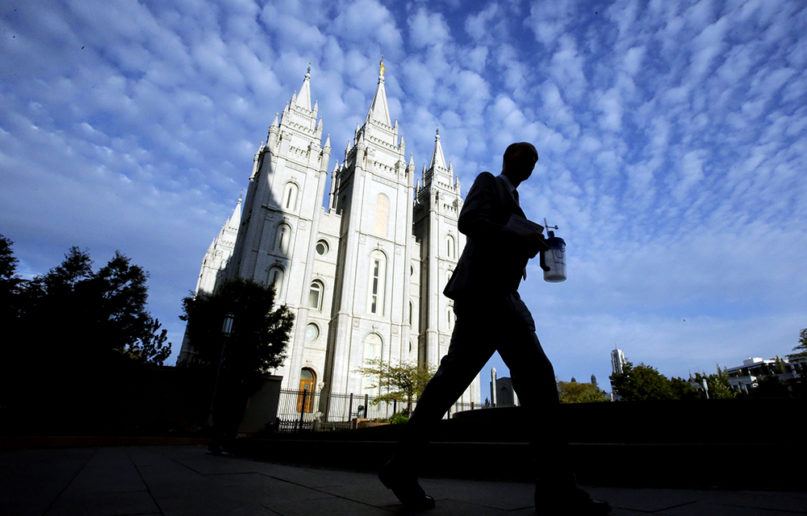(RNS) — I spend a lot of time with ex-Mormons these days, and they tend as a group to be rather cynical about the corporate machinations of The Church of Jesus Christ of Latter-day Saints. I’ve heard them spout the line “Follow the money” whenever we discuss anything about church policies or even doctrine, and there are times when I agree with them.
Strangely, when it comes to the Ensign Peak Advisors investment fund of more than $100 billion, I don’t think it’s about the money. I think it’s about loyalty. Stick with me here for a bit.
It appears that since the 1990s, the LDS church has channeled excess tithing money into a range of investments that are now worth over $100 billion, a tax-exempt treasure that is just sitting idle and making more money.
The idea that this much money is “a rainy day fund” is a bit fatuous, in my opinion. In my mind, a rainy day fund is one that might be enough money to cover the finances of the church for a year or two in the case of a massive financial downturn or even a full-on depression. Let’s say it’s for five years, even.
But if the annual operating expenses of the global church are around $6 billion (according to The Washington Post’s report), it appears this fund would be a rainy day fund for something like 15 years — a decade and a half in which the stock market completely failed and the money wasn’t earning any interest. This doesn’t seem to be a real possibility even in worst-case scenarios.
The idea that the church is saving $100 billion for the Second Coming of Christ seems even sillier to me. What does it mean to save money for the Second Coming? Is the money for Christ to use, the savior who threw the money lenders out of the temple and told us to render unto Caesar what was Caesar’s and unto God what was God’s? Surely he wouldn’t need money once he comes.

Mette Harrison. Courtesy photo
So is the money to get the church through Armageddon? I know there are some pretty scary scenarios out there with Gog and Magog, but I haven’t heard President Russell M. Nelson talk much about apocalyptic scenarios except perhaps in a physical sense. What happened to individual members keeping a year’s supply of food in case of an emergency? Has the church decided this massive fund is to keep us all in wheat and oil?
One hundred billion dollars and counting? That’s both excellent money management and a Depression-era level of stinginess. This scandal has made me see the LDS church relative to other church financial scandals as a bit of a nonstarter. LDS church leaders are well-compensated (see here), but they aren’t living high on the hog. They’re not using members’ tithing money to go on lavish trips or throw big parties for themselves (no, I’m not counting Nelson’s 95th birthday party as this, either).
Nor are they buying yachts, drinking expensive alcohol or spending money on upscale suits and ties (although Dieter Uchtdorf’s are very fine and I wish he’d start giving advice to the other apostles on fashion, but that is another article entirely).
In the end, it seems clear that whatever the leaders of the LDS church care about, it’s not getting money for themselves so they can enjoy a party life at age 80 and above. This isn’t about greed and maybe isn’t even about power. When people complain about Nelson asking members in Africa to pay tithing when the church has $100 billion, I really don’t think it’s because the church wants those “pennies.”
There’s something deeper going on. The repeated calls for tithing are about increasing loyalty in new members to the church, especially when it would be easy for those new members to simply slide back out of the fold. Asking those in poverty to give pennies to the church does little to increase that $100 billion fund, but it does make those members more invested in the future of the church. It’s a funny thing about human nature that demonstrating loyalty to an institution is the best way to increase loyalty to that institution.
When I was attending church regularly, I remember being told that the best way to build your testimony was to bear it, which in the Mormon tradition means to proclaim it out loud. And it was true, in a way. Bearing your testimony in front of other people was a great way to increase your loyalty to the institution. Why? Because it increased your investment, and that increased your likelihood to continue to invest.
You could call this an outgrowth of the well-known phenomenon of the sunk-cost fallacy, where people continue to invest in stock that they’ve already lost money in because they don’t want to admit they’ve lost money. So instead of changing course, they double down. Or you could simply say that it makes people value what they’ve sacrificed far more than they would have otherwise.
Many of the things the church does are about loyalty more than about money. Leaders want members to invest time, money and energy, and to sacrifice many things — not just money — to the church because the end result is that it makes them more devoted to it.
I’m not at all convinced that this is done nefariously. A lot of the church’s strategies are based on other corporate or religious organizations’ successful methods of building community and membership. But when I look at many different things the church asks its members to do, it feels to me that they are building loyalty rather than a stockpile of cash.
Asking us to clean the church building ourselves on Saturday mornings, rather than hiring a janitor like other religious groups do? This expectation was never about money. It was about sacrifice. It was about feeling ownership in the church building and changing our behavior while we’re in it.
Assigning us unpaid callings that require, in the case of some local leaders like bishops and Relief Society presidents, enough hours per week that it’s like having another job? This kind of lay leadership is also about sacrifice.
The church now has plenty of money to pay for clergy if it chose to, but maintaining a lay leadership increases devotion. It gives everyone a stake in the success of ward projects. It also helps members to grow spiritually as we face difficulties or even bad mistakes, our own or others’, which in turn increases our likelihood to see the church as the instrument of our growth and development.
Missions are about sacrifice, which makes them the No. 1 way to increase the likelihood of retaining the loyalty of the young adults who choose to serve.
Seminary, youth programs, stake camps, Trek, on and on. Personal sacrifice is the point of all of these programs. It makes those who participate want to stay more.
I’m not trying to excuse the church’s massive nest egg here, just point out a reality of what I see happening. Which is that it’s not about the money, stupid. It’s about loyalty.
Related posts:
How persuasive is whistleblower’s claim that the LDS Church is hiding wealth from the IRS?
I just paid my Mormon tithing. Why don’t I feel better about it?






